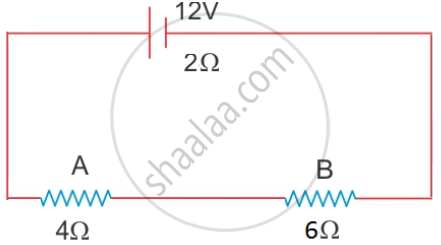Advertisements
Advertisements
प्रश्न
Keeping the potential difference constant, the resistance of a circuit is halved. By how much does the current change?
उत्तर
From Ohm's law we have:
V/I = R
Or I = V/R
Now, according to the question, the resistance of the circuit is halved and the potential difference is constant.
i.e. R' = R/2
and V' = V
Then the new current is given by:
I' = V'/R'
= V/R/2
= 2V/R
= 2I
It is clear from the above statement that the current becomes double.
APPEARS IN
संबंधित प्रश्न
Calculate the quantity of heat produced in a 20 Ω resistor carrying 2.5 A current in 5 minutes.
A battery of emf 12 V and internal resistance 2 Ω is connected with two resistors A and B of resistance 4 Ω and 6 Ω respectively joined in series.

Find:
1) Current in the circuit
2) The terminal voltage of the cell
3) The potential difference across 6Ω Resistor
4) Electrical energy spent per minute in the 4Ω resistor.
How much work is done when one coulomb charge moves against a potential difference of 1 volt?
What do you understand by the term "potential difference"?
Keeping the potential difference constant, the resistance of a circuit is doubled. By how much does the current change?
If the potential difference between the ends of a fixed resistor is halved, the electric power will become:
A current of 1.6 mA flows through a conductor. If charge on an electron is –1.6 × 10-19 coulomb, find the number of electrons that will pass each second through the cross section of that conductor.
A cell of e.m.f 2.0 V and internal resistance 1Ω is connected to the resistors of 3Ω and 6Ω in series. Calculate:
(i) the current drawn from the cell,
(ii) the p.d. across each resistor,
(iii) the terminal voltage of the cell and
(iv) the voltage drop.
An electric bulb draws 0.5 A current at 3.0 V. Calculate the resistance of the filament of the bulb.
Twenty-seven drops of the same size are charged at 220 V each. They combine to form a bigger drop. Calculate the potential of the bigger drop.
